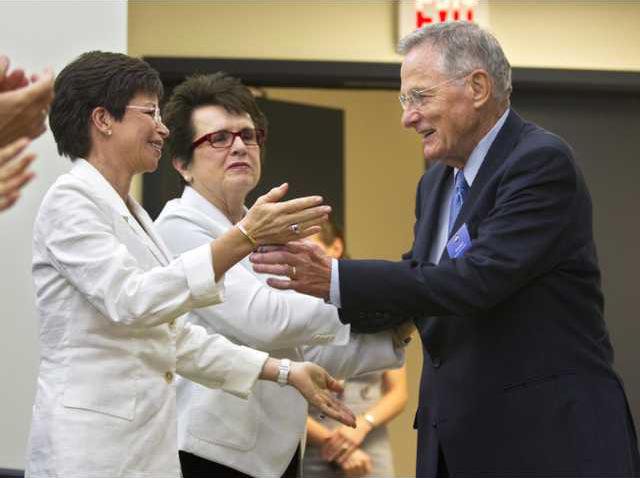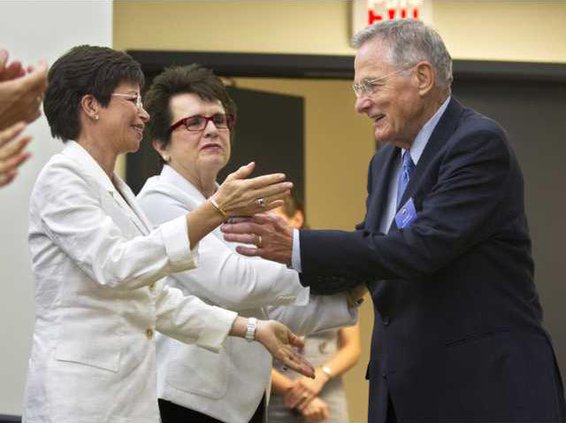NORTHFIELD, Ill. — Emily Miller remembers learning about Title IX during history class, probably sometime in junior high. She's a little fuzzy on the details, including how and why it came about.
Every time she steps on the soccer field, though, she feels its effect.
At 16, Miller can't even imagine who she'd be without the game. She's played since kindergarten, and credits soccer for her independence and self-confidence. Now a starter on the varsity team at New Trier High School in suburban Chicago, she's proud when someone describes her as "the athlete" or "the soccer player."
"Soccer," she said, "is what makes me Emily Miller."
As Title IX celebrates its 40th anniversary today, the WNBA is in its 16th season, Hope Solo and Natalie Coughlin will be two of the biggest names at the London Olympics and participation numbers for women in college and high school athletics are at an all-time high. But perhaps the greatest legacy of the legislation originally intended to prohibit discrimination in education is found in Miller and the hundreds of thousands of girls like her: a generation of young women growing up strong and self-assured because of their participation in sports. A generation for whom sports is so ingrained in their lives, they can't fathom being on the sidelines.
The words "sports" or "athletics" are not even mentioned in Title IX. At a time when women earned 9 percent of all medical degrees and just 7 percent of law degrees, Bayh and the other Title IX supporters were simply hoping to provide more opportunities for women in higher education, give them a better shot at higher-paying jobs.
"It was clear that the greatest danger or damage being done to women was the inequality of higher education," Bayh said. "If you give a person an education, whether it's a boy or girl, young woman or young man, they will have the tools necessary to make a life for families and themselves."
But just as admissions numbers and financial aid fell under the broad definition of "education program," so, too, did athletics.
"Sport is an educational opportunity. You learn about yourself and the world through sport," said Angela Ruggiero, president-elect of the Women's Sports Foundation and a member of the 1998 U.S. team that won the first Olympic gold medal in women's ice hockey.
It wouldn't be enough for schools to tack sign-up sheets on a bulletin board and count that as a team, or clear out a storage closet and call it a locker room. Title IX called for equal opportunity to play, and that meant schools had to offer scholarships and provide the same access to equipment, coaching and facilities.
Some prominent coaches and athletic directors, worried that Title IX would gut football, pushed to have revenue sports — namely football — excluded from the compliance formula. But their attempt to amend the legislation in 1973 backfired. Spectacularly.
The Department of Health, Education and Welfare was instead ordered to develop a framework for how Title IX was to be interpreted and followed, with most of the regulations addressing athletics. It was these rules, issued in 1975, that provided the backbone for the legislation and have allowed it to withstand repeated challenges in court.
"They could have gotten exemptions for the big sports ... if they didn't cry so much about it," said Donna Lopiano, who has been at the forefront of defending Title IX, first as the women's athletics director at Texas from 1975-92 and then as CEO of the Women's Sports Foundation from 1992 to 2007. "It created this media attention that allowed the women to voice the benefits of sport for boys and girls, and they convinced the public and Congress this was important for boys and girls. That was a tremendous accident."
Once given the chance, girls flocked to the playing fields.
Before Title IX, fewer than 300,000 high school girls — one in 27 — played sports; there were less than 32,000 female athletes at the collegiate level. By 1974, just two years after the passage of Title IX, the number of high schoolers participating in sports had skyrocketed to 1.3 million.
Now more than 3 million high school girls — one in two — play sports. More than 191,000 females played NCAA sports in 2010-11. And unlike their mothers or grandmothers, who were often limited to basketball and softball if they did get a chance to play, women are now participating in everything from squash to skiing, rugby to wrestling.
"Title IX was the second-most important piece of civil rights legislation passed in this country," said Debbie Yow, athletic director at N.C. State. "Had it not passed, the options and opportunities for women in this country and the world would be vastly different."
Aside from the general health benefits of any physical activity, studies have shown that female athletes do better in school and have higher graduation rates. White female athletes had a 74 percent graduation rate compared with 68 percent for the overall student body, according to the most recent federal government calculations. The graduation rate for black female athletes was 66 percent, compared with just 46 percent in the overall student population.
A 2002 survey by Oppenheimer Funds found that 82 percent of female business executives had played organized sports after elementary school.
"We compete every day in life, and it taught us how to in a healthy way," Yow said. "In a more comprehensive way, it taught us how to lead."
Female athletes are also less likely to smoke, use drugs or be suicidal. And, according to the Women's Sports Foundation Report: Sport and Teen Pregnancy, published in 1998, teenage athletes were less than half as likely to get pregnant as non-athletes, and are more likely to delay having sex for the first time.
The intangible benefits may be even greater.
It's not just women whose mindset has changed over these last 40 years. Boys have grown up watching sisters, friends, classmates, even their mothers play sports, and the distinction between an "athlete" and a "female athlete" has faded. All four of tennis' Grand Slam tournaments pay equal prize money to the men's and women's winners. Last year's Women's World Cup final between the United States and Japan earned the highest television rating for any soccer game on an ESPN network.
For all the strides female athletes have made, however, the playing field is not yet even. Women typically make up more than half of the student population, but were only 43 percent of the athletes last year, according to the NCAA. A 2007 study found that female athletes had received only 35 percent of total athletic expenditures in 2004-05. In the latest update of their "Women in Intercollegiate Sport" study, R. Vivian Acosta and Linda Jean Carpenter found there were 215 female athletic directors at NCAA schools in 2012. But only 36 were in Division I, and less than 5 percent of those were at Football Bowl Subdivision schools, the power brokers in collegiate sports.
And even though Title IX has been upheld by the courts time and again, it remains a matter of debate in the court of public opinion. There was a net loss of 300 men's teams in Division I between 1988-89 and 2009-10, according to the NCAA, and Title IX is often blamed for the cuts. Never mind that there's nothing in the legislation about cutting men's teams to create opportunities for women. Or that the huge size — and expense — of football squads creates an inherent imbalance.
"There's a lot more gains to be had," Ruggiero said. "I think there's a lot more room for growth, certainly in the participation numbers."
As Title IX turns 40, its legacy extends beyond numbers





